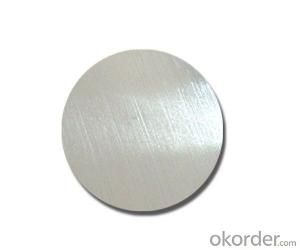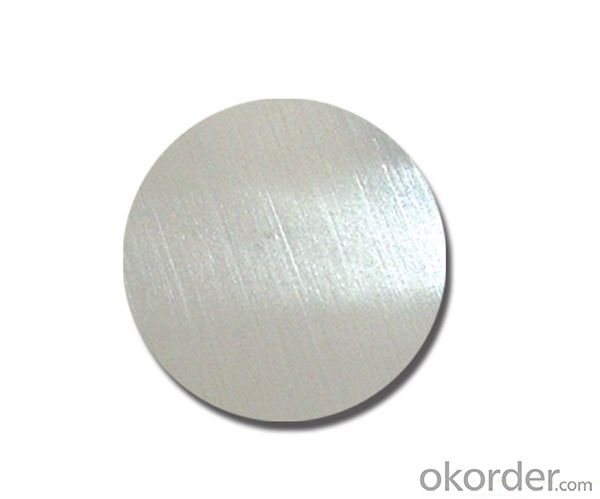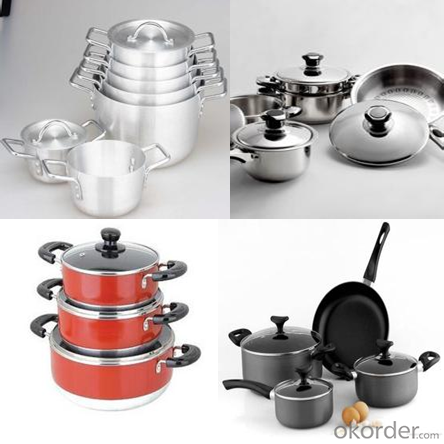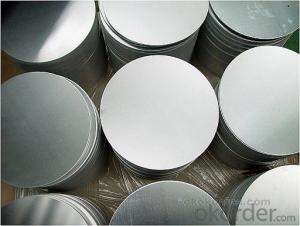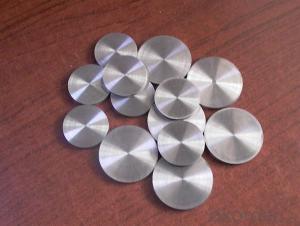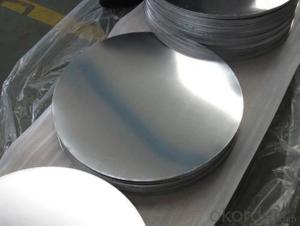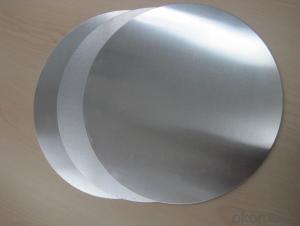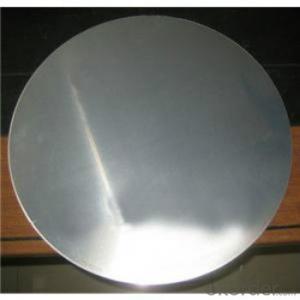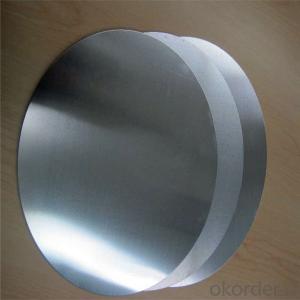Aluminum Alu Circles and Discs for Cookware Manufacturing
- Loading Port:
- Shanghai
- Payment Terms:
- TT OR LC
- Min Order Qty:
- 5 m.t.
- Supply Capability:
- 1000000 m.t./month
OKorder Service Pledge
OKorder Financial Service
You Might Also Like
Specification
1.Structure of Alu Circles and Discs for Making Aluminium Cookwares Description
• Product: Aluminim Circle
• Application: It is used in cookware, engineering, lighting purpose, fried pans, non-sticky pans, cooking pots, kettles, hard anodize cook wire, pressure cooker and house hold utensils, reflector of the light, etc
• Advantage: Deep drawing and hard anodizing quality Aluminum Circle Sheet can be supplied. Our Aluminum Circle is RoHS and REACH compliance and uses well-protected packing. Our circles are excellent material for producing cookware, utensil, pots, pans and kettles.
2.Main Features of the Alu Circles and Discs for Making Aluminium Cookwares
• High manufacturing accuracy
• Smooth surface
• No waves
• High strength of extension and yield
• Well packaged
3.Alu Circles and Discs for Making Aluminium Cookwares Images
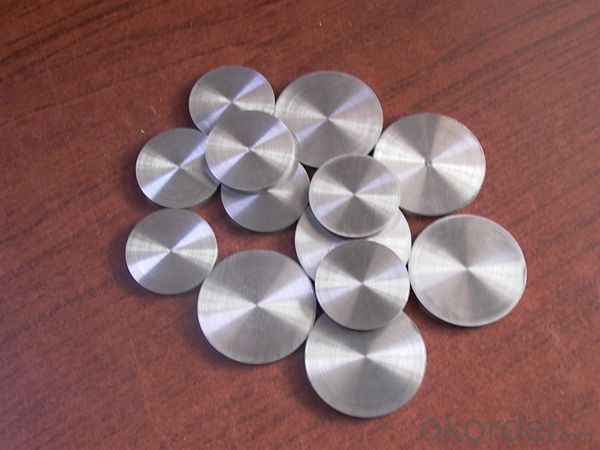

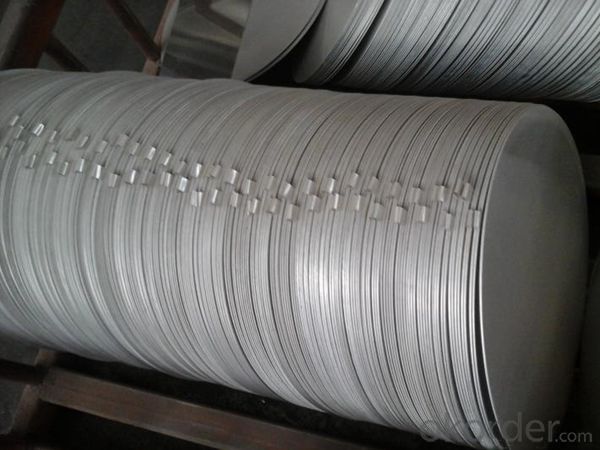
4.Alu Circles and Discs for Making Aluminium Cookwares Specification
Alloy | AA1050,AA1060,AA1100 AA3003etc. |
Temper | O,H14 |
Thickness | 0.5MM-4MM |
Diagonal | 100-1200MM |
Standard | GB/T 3880-2006 |
5.FAQ of Alu Circles and Discs for Making Aluminium Cookwares
We have organized several common questions for our clients,may help you sincerely:
①How about your company?
A world class manufacturer & supplier of aluminum coil and alloy blanks. Aluminum production base is comprised of 18 aluminum annealers, 10 coil and foil mills, 4 continuous production lines, 2 hot rolling production line and 3 prepainted lines.
Export 5000 tons per month to Asia, America and Middle East. Always do the best for our clients.
②Can you guarantee the quality of the products?
We are responsible for the quality of materials to get a long-term cooperation with clients in a reasonable period of time and we are glad to arrange and coordinate any third party inspection for you.
③What is the delivery time after purchase?
35 day after receiving client’s deposit or correct LC
5.Quality contral:
1. Professional Quality Control Team
v Inspecting ingot before melting
v Inspecting aluminium coil stock before cold rolling
v Inspecting finished goods before package
v Inspecting package, loading before shipment
2. Guaranteed by ISO 9001:2008 (SGS)
3. Guaranteed by FDA, EN 602, TPCH etc
- Q: This question asks whether exposure to aluminum can lead to allergic reactions.
- <p>While aluminum is one of the most abundant elements on Earth and is commonly used in various products, most people do not experience allergic reactions to it. However, a small percentage of individuals may have an allergy to aluminum, which can cause contact dermatitis or other allergic responses. Symptoms can include redness, itching, and swelling at the site of contact. It's important for those with known aluminum allergies to avoid products containing aluminum and to consult with a healthcare provider for proper diagnosis and management of their allergy.</p>
- Q: Is it possible to recycle aluminum using renewable energy sources such as solar or wind power?
- <p>Yes, aluminum can be recycled using solar energy or wind energy. The recycling process involves melting the aluminum, which can be powered by electricity generated from renewable sources. Solar panels and wind turbines can produce the electricity needed for this process, reducing the carbon footprint associated with aluminum recycling. In fact, recycling aluminum requires only 5% of the energy needed to produce new aluminum from raw materials, making it an energy-efficient process that benefits significantly from renewable energy sources.</p>
- Q: What are the distinctions between aluminum foil and aluminum sheet in terms of thickness, usage, and properties?
- <p>Aluminum foil and aluminum sheet are both made from aluminum but differ in thickness and usage. Aluminum foil is very thin, typically ranging from 0.0005 to 0.1 inches, and is used for food packaging, cooking, and insulation. It is lightweight, flexible, and has excellent barrier properties against light, air, and moisture. Aluminum sheet, on the other hand, is thicker, usually from 0.2 to 2 inches, and is used in construction, automotive, and aerospace industries due to its strength and durability. It is less flexible than foil but offers greater rigidity and can withstand higher temperatures and pressures.</p>
- Q: Is it possible to recycle aluminum cans and turn them into new cans?
- <p>Yes, aluminum cans can be recycled into new ones. The recycling process involves melting the used cans, which is much less energy-intensive than extracting and refining new aluminum from bauxite ore. Once melted, the aluminum can be reshaped into new cans or other products. This process is not only environmentally friendly but also economically efficient, as it saves energy and reduces waste.</p>
- Q: This question asks for methods to prevent aluminum from seeping into food when cooking with aluminum cookware.
- <p>To prevent aluminum from leaching into food when using aluminum cookware, follow these guidelines: Avoid using aluminum cookware for acidic foods or beverages, as acids can cause aluminum to leach. Do not cook with high heat, as this can increase the risk of leaching. Use a protective coating, such as a non-stick coating or a thin layer of oil, to create a barrier between the food and the aluminum. Regularly replace or repair any damaged cookware to prevent exposure to bare aluminum. Finally, consider using alternative cookware materials, such as stainless steel or cast iron, for long-term cooking and storage.</p>
- Q: This question asks about the chemical reaction between aluminum and elements in the halogen group.
- <p>Aluminum reacts with halogens to form aluminum halides. The reaction is typically exothermic and can be represented by the general equation: 2Al + 3X2 鈫?2AlX3, where X represents a halogen (fluorine, chlorine, bromine, iodine, or astatine). For example, when aluminum reacts with chlorine, it forms aluminum chloride (AlCl3). The reaction is often initiated by heating the aluminum, which is then rapidly oxidized by the halogen. This process is used industrially to produce aluminum halides, which are important in various chemical applications.</p>
- Q: Is it possible to utilize aluminum in the construction or components of electronic devices?
- <p>Yes, aluminum is commonly used in electronic devices. It is valued for its lightweight, high thermal conductivity, and corrosion resistance. Aluminum is often used in heat sinks to dissipate heat from electronic components, as well as in the casings of devices for structural support and durability. Additionally, aluminum is used in the manufacturing of electrolytic capacitors and serves as a conductive material in various electronic components due to its good electrical conductivity.</p>
- Q: This question asks about the potential health consequences of being exposed to high levels of aluminum.
- <p>Excessive aluminum exposure can lead to various health effects. It has been linked to neurological disorders, including Alzheimer's disease, as it may accumulate in the brain and disrupt normal function. It can also cause bone diseases by interfering with calcium absorption, leading to osteomalacia and osteoporosis. Gastrointestinal issues such as constipation, colic, and even ulcers may arise due to aluminum's impact on the digestive system. Additionally, aluminum exposure has been associated with anemia, as it can inhibit the absorption of iron. While the extent of aluminum's toxicity is still a subject of debate, it is generally advised to minimize exposure to high levels of aluminum to avoid potential health risks.</p>
- Q: Is it safe to use aluminum containers for food and drink in a microwave?
- <p>Aluminum is not recommended for use in microwave-safe containers for food and drink. While some aluminum containers are designed to be microwave-safe, they are typically coated with a non-metallic material to prevent arcing and damage to the microwave. However, most aluminum containers are not safe for microwave use as they can cause sparks and potentially damage the microwave. It's best to use microwave-safe plastics, glass, or ceramics specifically designed for microwave use.</p>
- Q: Is aluminum a suitable material for constructing aerospace structures?
- <p>Yes, aluminum is widely used in aerospace structures due to its high strength-to-weight ratio, corrosion resistance, and ease of fabrication. It is particularly favored for aircraft frames, wings, and fuselage components. Aluminum alloys are also used in spacecraft and satellite structures for their lightweight properties and ability to withstand extreme temperatures.</p>
Send your message to us
Aluminum Alu Circles and Discs for Cookware Manufacturing
- Loading Port:
- Shanghai
- Payment Terms:
- TT OR LC
- Min Order Qty:
- 5 m.t.
- Supply Capability:
- 1000000 m.t./month
OKorder Service Pledge
OKorder Financial Service
Similar products
Hot products
Hot Searches
